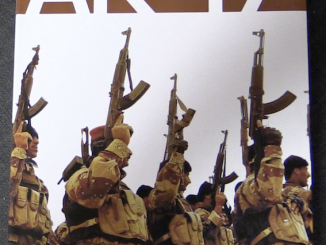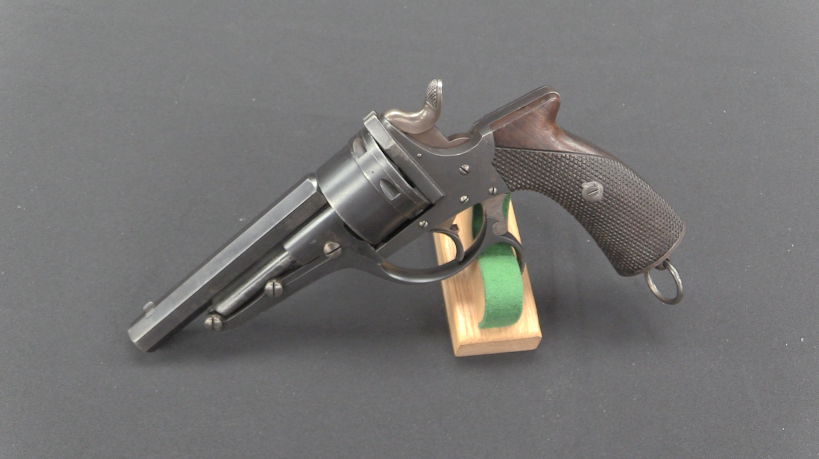Russian small arms researcher Max Popenker joins us again today, and this time he is discussing the history and development of the Dragunov rifle. We start from the desire to match longer-ranged NATO forces and the competition between Simonov, Konstantinov, and Dragunov through its development and adoption. Then various experiments in flechettes and larger and smaller cartridges, as well as the bullpup SVU rifles. Finally, we cover the interactions of modernized Dragunovs through the SVD-M currently in use. Max presents a fascinating history of the rifle, the likes of which you will not find anywhere else in English!
Related Articles

Video
Warsaw Uprising
I normally have a book review on Thursday, but this week I’m pushing it to Friday. I meant to post this yesterday, but lost track of the date – which, 69 years ago, was the […]

Book review
Book Review: AK47 – The Grim Reaper (Second Edition)
The expanded second edition of Frank Iannamico’s “AK47: The Grim Reaper” is a hefty 1100-page tome which tackles the ambition goal of being a single reference for all things Kalashnikov. Ot begins with a section […]

Revolver
RIA: Russian M1870 Galand Revolver (Video)
The Galand was an innovative revolver design created by Frenchman Charles Francois Galand and patented in 1868. It is most notable for using a long lever system to eject cartridges by throwing the cylinder and […]

Welcome Back Max! LOVE this rifle, well hell of them.
That’s not an area of real interest to me and I hung on every word. Fascinating and very enjoyable. Thank you!
One addition: among original competitors was also design by M.T.Kalashnikov, see upper-right quarter of 1st image from top:
https://www.thefirearmblog.com/blog/2016/11/09/four-forgotten-firearms-designed-mikhail-kalashnikov/
it shares many solutions with his earlier fire-arms (AK, RPK) and was bit lighter than Dragunov, but dispersion was found to not meet requirements, thus it was rejected.
That 10mm flechette smoothbore concept is very interesting. Certainly more promising than the high pressure 6mm round the Soviets also fooled around with.
Perhaps for improved small arms ammunition a happy medium course would be to use a squeeze bore projectile, perhaps with a plastic jacketed bullet. That way you avoid the manufacture and dispersion problems of a sabot projectile, and reduce the barrel wear and high pressure problems of a small bore high velocity projectile.
Here (5th image from top): https://topwar.ru/134003-strelovidnye-puli-put-lozhnyh-nadezhd-ili-istoriya-upuschennyh-vozmozhnostey-chast-2.html you might see some Soviet Cold War-era experimental cartridges:
2) rifle 10/4,5 mm single bullet
3) rifle 6×54 mm (1981)
3) unified 10/3,5 mm single bullet
4) unified 10/2,5 mm tri-bullet
1), 6), 7) are common cartridge for size comparison, unified means destined both for rifles and avtomat.
Thanks for the link. I’m just reading the translation…
Developmental history. The way something as hoary as 7.62 X 54 can be ‘grandfathered’ on, generation after generation. At least they weren’t stuck with Lebel!
For what it may be worth. In the African bush wars (Rhodesia and Namibia) the only Sovbloc small arms that produced casualties, as opposed to noise, were the PK GPMG and the SVD. They were both devoutly hated. The insurgents still got beat but the price was higher.
Wafa Wafa, Wasara Wasara.
Who were trained snipers on the other side ? I think its not a tool for your regular barefoot bushwhacker.
What seem to come out of this articulated and almost planned-like Max’s speech is that Soviet and later Russian military has held simple and logical line – step by step, no big changes, trying small variations and mainly NOT to take big risk. Not exactly the same as often wasteful approach as practised by U.S. Army.
Also and mainly, financial constrains had been big factor for Russian army. You cannot fault them what they have done; it makes sense. There are many other areas of military which need attention.
Yeah, I think the US Army has always tried to stay ahead of the game. They’ve tried to stay FAR ahead of the game and fumbled the ball too many times because they wanted to have so big an advantage in war that everyone else would just cower and beg them for mercy without fighting for even a single DAY!
True and this in a way helped according to Mr. Popenker the Russian small arms designers with their future trend determination.
The U.S. Army and its acquisition branch makes, with small exceptions, no secrets about technical details of their developments. Pertaining material is freely available to their potential opponents. This permits others to direct their trend in more desirable direction, with less funds and efforts, ironically for money of U.S. taxpayer.
Does it make any sense?
Pretty much. If Kirk has anything to say about this, Army Ordnance is still stuck in the Middle Ages in terms of what NOT to tell your opponents. Bragging about your ability to wipe an army off the face of the planet with a nuke-launching railgun hurts more than it helps, for example!
“(…)freely available(…)”
This need some explanation, Soviets showed regarding much different mentality regarding knowledge (shortly: my precious) especially but not only military ones.
Making no secrets about technical details of their developments made getting it for Soviets easier, nonetheless even if it were secret, then was possibility of Soviet getting them through espionage. Regarding small arms development, it is worth noting that in Soviet Union, it was more influenced by concept than particular technical solutions of Western weapons. Take for example PROJECT ABAKAN with many of its numerous contenders:
https://guns.fandom.com/wiki/Project_Abakan
providing option of short burst, fired with extraordinary Rate-of-Fire (2 bullets and 1800 rpm for finally accepted AN-94) and note that feature similarity to… G11 (although here with 3 bullets and additionally smaller bullet and case-less and…)
Finally, keep in mind, if Soviets released some knowledge, it was after considering possible consequences. Take for example stealth aeroplanes for which theoretical base was developed by citizen of Soviet Union:
https://en.wikipedia.org/wiki/Petr_Ufimtsev
and published internationally in 1970s. This naturally lead to question:
Why? Did not Soviet realized what it allows to accomplish?
They did, however they concluded such aeroplane would be inferior in other aspects of performance to similar-sized classic one and would require a lot of resource, resulting in extremely unfavorable cost-effect ration.
We must not forget that America’s military-industrial complex is also in the business of foreign arms sales. These sales represent a mutual benefit for the Pentagon and its corporate partners:
1. larger production runs to cover the staggering r&d costs (F-35)
2. trapping buyers into dependence on US supply chains and thus fearing US sanctions for future disobedience
But the first hit is free, as the drug dealers say. You have to get the customer to believe your new superweapon is really super, and that means you must spill a lot of proprietary information.
Now conversely, why would the USSR not go about it that way?
1. Soviet production runs were already large; it rarely sold its newest weapons outside of the Warsaw Pact
2. if the richer countries were more likely to be capitalist and pro-US, then that left poorer countries (except maybe Libya) to buy Soviet arms. Beggars can’t be as choosy about capabilities. However, that also means that the Soviets are the seller of last resort; if you get cut off by Moscow, you probably can’t afford American stuff anyway, unless you’ve got enough strategic importance to offset lack of $ (Egypt, biggest US aid recipient).
So buying >10-year-old Soviet gear means instead of relying on lobbyist/arms show hype, you rely on whatever field experience you can find out about. The Soviets don’t have to tell anyone how their new stuff works.
Different priorities for both the buyer and seller.
He touched briefly on SVCh rifle by Kalashnikov concern which is being developed lately and which may replace SVD. At least that is what Max’s page says. It is prototyped in both 7.62x54R and .308 Win.
Its core is a steel “spine” which contains trunnion, buffer, action guides and optical rail. Rest is primarily light alloy.
One more thought and this is more or less obvious, but rarely spoken of.
All rifles including sniper/ DMR types are dogged by effects of shot, namely flame, noise and as far as user is concerned for most part – by recoil force which throws them off intended target. The famous FG 43 dealt at least partially with the problem while employing telescoping buttstock. I wonder why this concept is not applied currently especially for rifles which have to be within certain weight limit (cannot not resist recoil force by its mass alone).
Sniper needs only one round, if he missed, its better to run and hide than try second shot. Fg42 configuration as well as open bolt automatic was best for bursts.
Great show , I always enjoy real solviet imput
This is an excellent presentation from which I learned a lot. I particularly liked how developments like SVD-K and SVD-M were set into perspective.
Small addition: folding stock version presented is generally known as SVD-S with last S standing for folding. http://gunrf.ru/rg_vintovki_svd-s_eng.html
Enjoyable and informative. The basic concept of “7.62×39 lacks range vs 7.62×51, so we need a squad level marksman rifle” guided the development and makes sense. It wasn’t supposed to be a 1000m super sniper rifle.